A New Spaceborne Burst Synthetic Aperture Radar Imaging Mode for Wide Swath Coverage
Abstract
:1. Introduction
2. TOPS Imaging Mode
2.1. TOPS Mode Review
2.2. Performance Analysis in Azimuth
2.3. Timeline Design in TOPS
3. ETOPS Imaging Mode
4. System Design
5. Conclusions
Acknowledgments
Author Contributions
Conflicts of Interest
References
- Currie, A.; Brown, M.A. Wide-swath SA. Proc. Inst. Elect. Eng. F 1992, 139, 123–135. [Google Scholar]
- Moore, R.K.; Claassen, J.P.; Lin, Y.H. Scanning spaceborne synthetic aperture radar with integrated radiometer. IEEE Trans. Aerosp. Electron. Syst 1981, 17, 410–420. [Google Scholar]
- Guarnieri, A.M.; Prati, C. ScanSAR focussing and interferometry. IEEE Trans. Geosci. Remote Sens 1996, 34, 1029–1038. [Google Scholar]
- Holzner, J.; Bamler, R. Burst-Mode and ScanSAR Interferometry. IEEE Trans. Geosci. Remote Sens 2002, 40, 1917–1934. [Google Scholar]
- Rosen, P.; Hensley, S.; Joughin, I.R.; Li, F.K.; Madsen, S.; Rodríguez, E.; Goldstein, R. Synthetic aperture radar interferometry. Proc. IEEE 2000, 88, 333–382. [Google Scholar]
- Zan, F.D.; Guarnieri, A.M. TOPSAR: Terrain observation by progressive scans. IEEE Trans. Geosci. Remote Sens 2006, 44, 2352–2360. [Google Scholar]
- Xu, W.; Huang, P.-P.; Deng, Y.-K. TOPSAR data focusing based on azimuth scaling preprocessing. Adv. Space Res 2011, 48, 270–277. [Google Scholar]
- Xu, W.; Huang, P.-P.; Deng, Y.-K.; Sun, J.-T.; Shang, X.-Q. An efficient imaging approach with scaling factors for TOPS mode SAR data focusing. IEEE Geosci. Remote Sens. Lett 2011, 8, 929–933. [Google Scholar]
- Meta, A.; Mittermayer, J.; Prats, P.; Scheiber, R.; Steinbrecher, U. TOPS imaging with TerraSAR-X: Mode design and perfomance analysis. IEEE Trans. Geosci. Remote Sens 2010, 48, 759–769. [Google Scholar]
- Meta, A.; Prats, P.; Steinbrecher, U.; Mittermayer, J.; Scheiber, R. TerraSAR-X TOPS and ScanSAR Comparison. Proceedings of the 7th European Conference on Synthetic Aperture Radar (EUSAR), Friedrichshafen, Germany, 2–5 June 2008.
- Attema, E.; Davidson, M.; Floury, N.; Levrini, G.; Rosich, B.; Rommen, B.; Snoeij, P. Sentinel-1 ESA’s New European Radar Observatory. Proceedings of the 7th European Conference on Synthetic Aperture Radar (EUSAR), Friedrichshafen, Germany, 2–5 June 2008; 2, pp. 179–182.
- Xu, W.; Deng, Y.K. Investigation on electronic azimuth beam steering in the spaceborne SAR imaging modes. J. Electromagn. Wave. Appl 2011, 25, 2076–2088. [Google Scholar]
- D’Aria, D.; de Zan, F.; Giudici, D.; Guarnieri, A.M.; Rocca, F. Burst-mode SARs for wide-swath surveys. Can. J. Remote Sens 2007, 33, 27–38. [Google Scholar]
- Wollstadt, S.; Prats, P.; Bachmann, M.; Mittermayer, J.; Scheiber, R. Scalloping correction in TOPS imaging mode SAR data. IEEE Geosci. Remote Sens. Lett 2012, 9, 614–618. [Google Scholar]
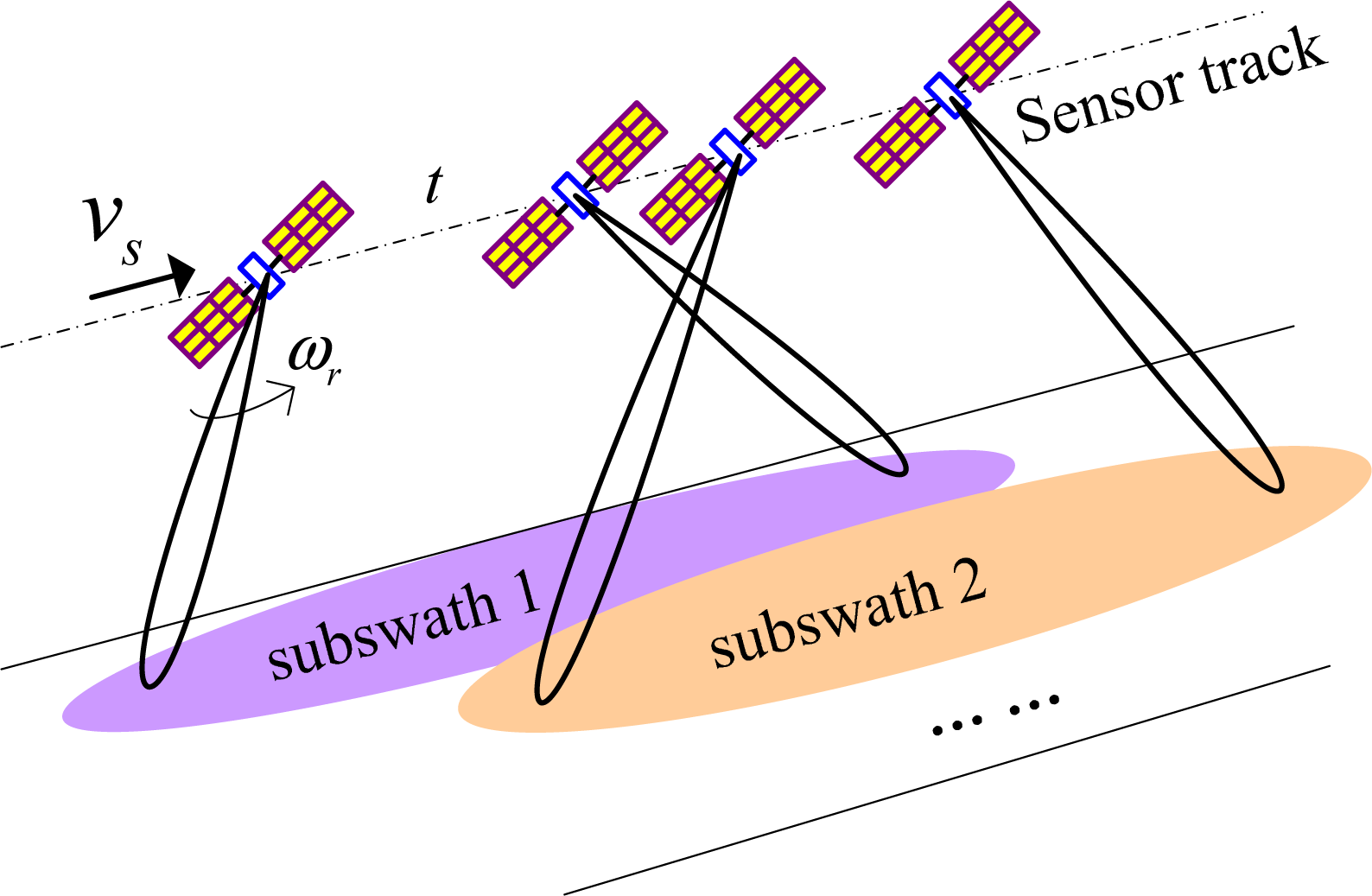
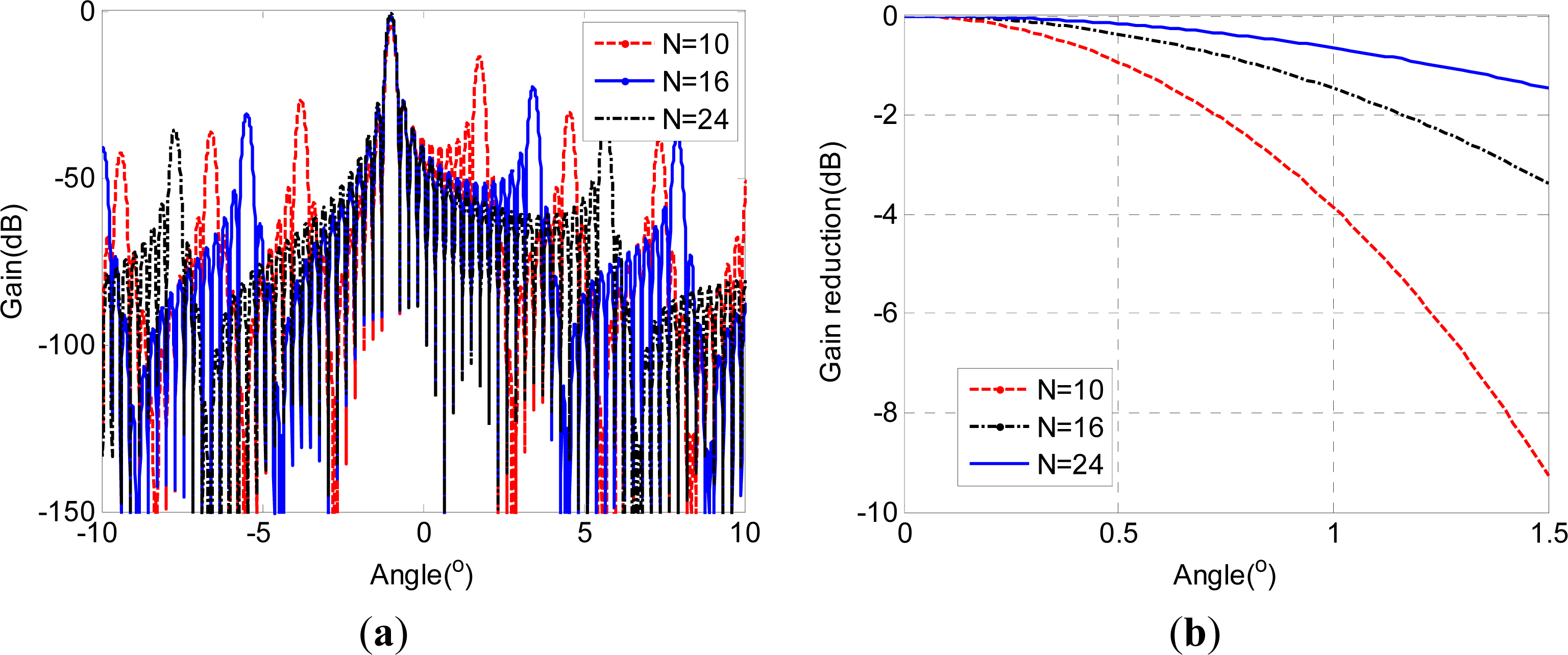

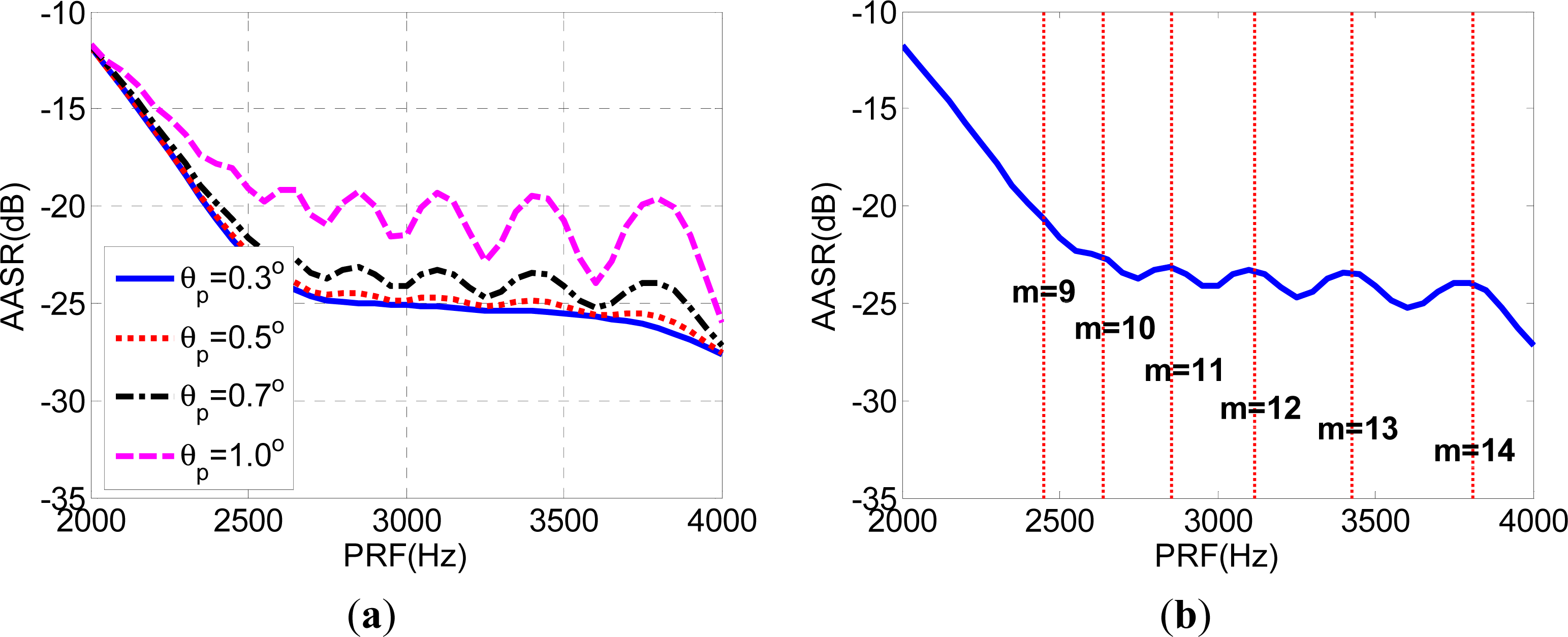
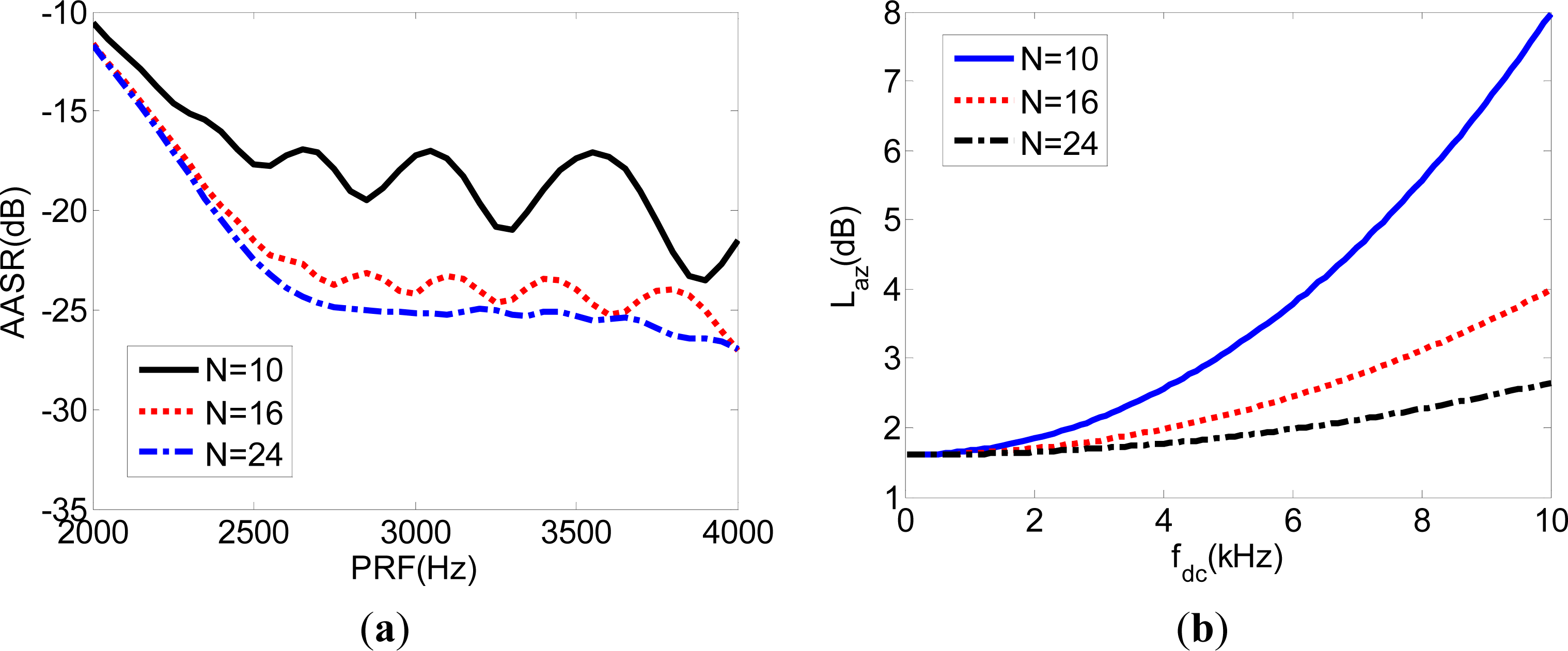
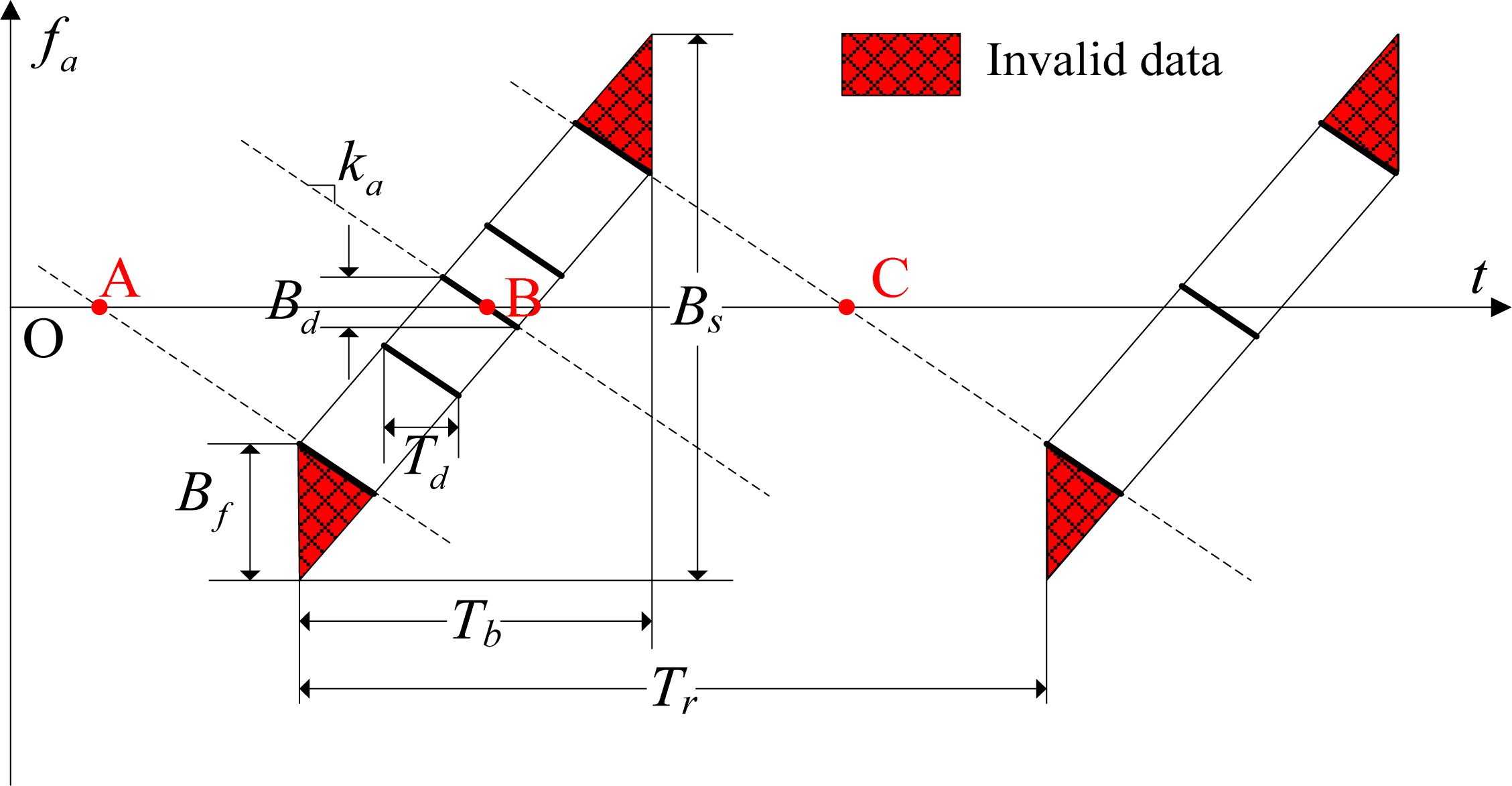
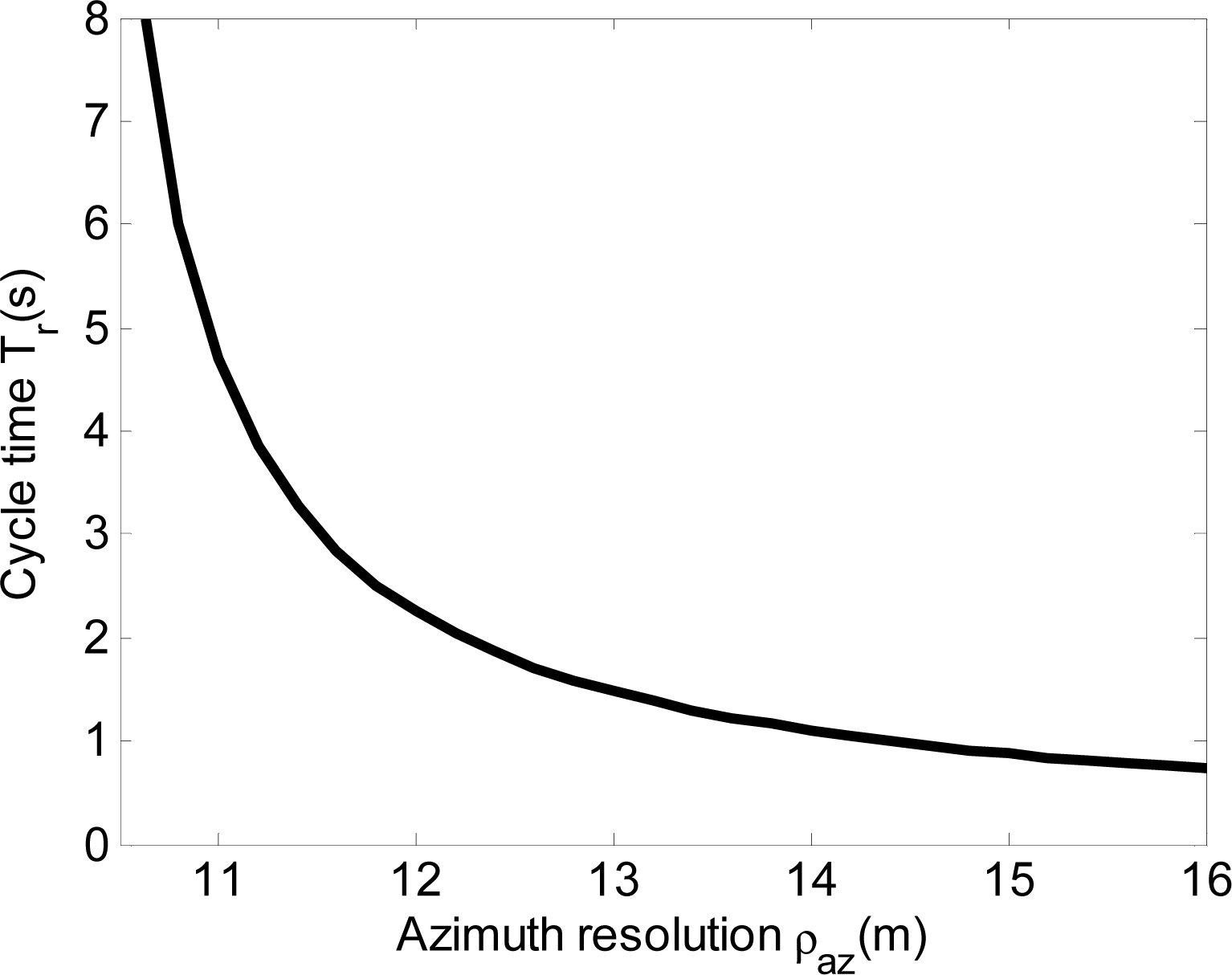
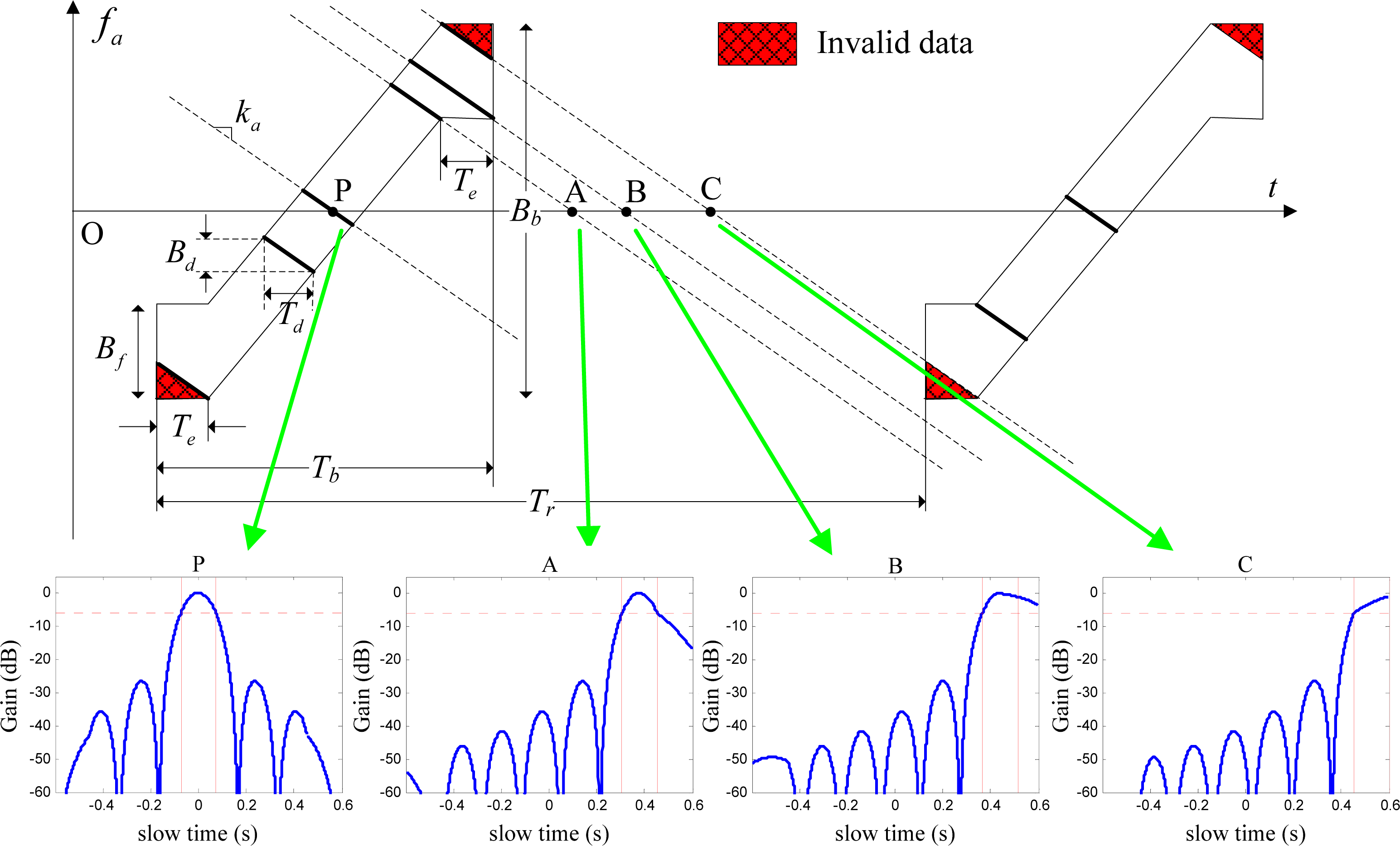
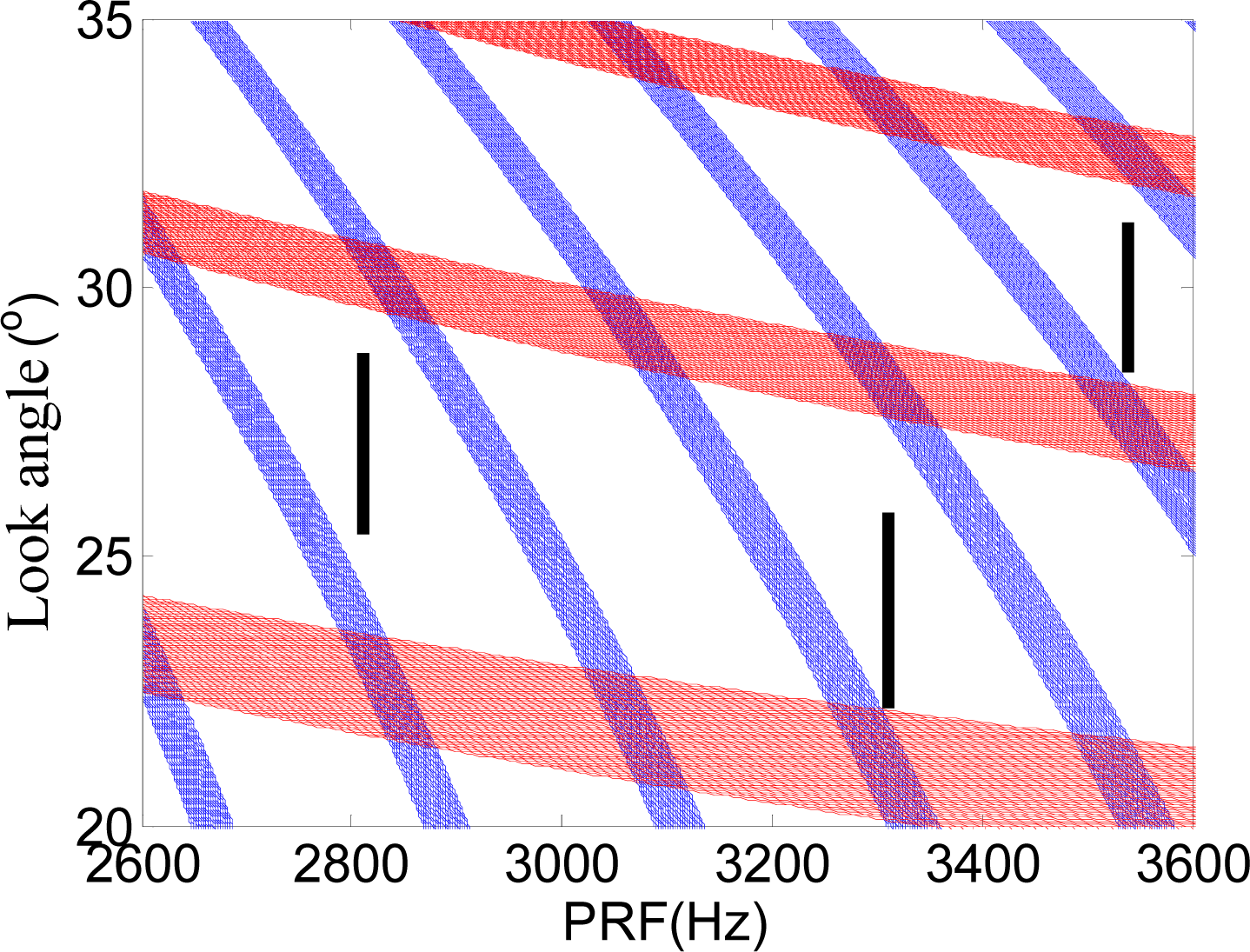
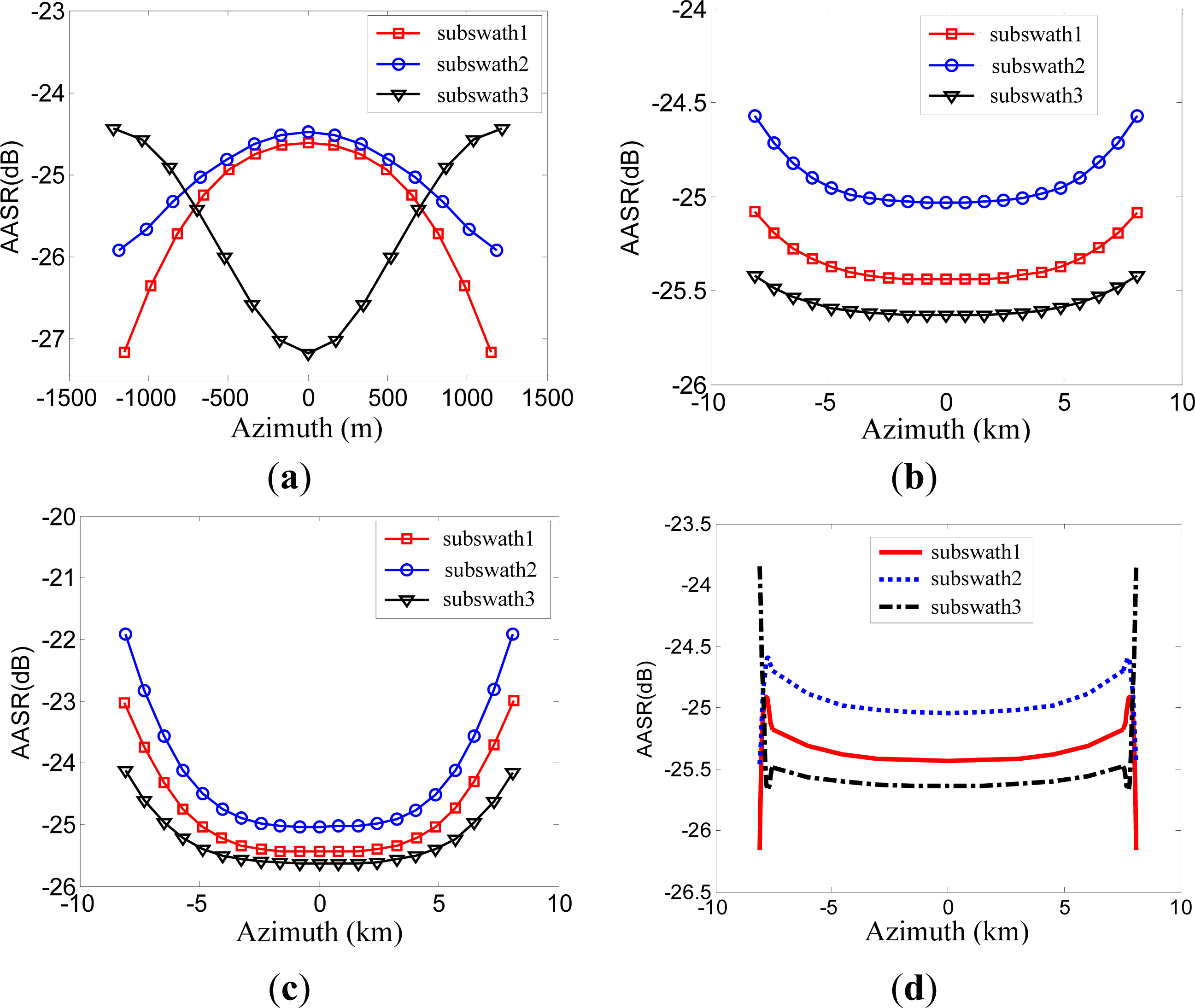

| Parameters | Value |
|---|---|
| Height of satellite H (km) | 630 |
| Satellite velocity vs (m/s) | 7,554 |
| Carrier frequency f0 (GHz) | 9.65 |
| Look angle (°) | 15∼45 |
| Transmitted pulse width τp (μs) | 40 |
| Azimuth antenna length La (m) | 6.4 |
| Elevation antenna height Lr (m) | 0.60 |
| Number of Transmit/Receive (T/R) modules | 16 × 20 |
| Transmit peak power (W) | 2,560 |
| Swath width (km) | ≥120 |
| Azimuth resolution ρaz (m) | ≤15 |
| Azimuth Ambiguity to Signal Ratio (AASR) (dB) | ≤−20 |
| Overlap ratio | 5% |
| Sub-Swath | Sub-Swath-1 | Sub-Swath-2 | Sub-Swath-3 |
|---|---|---|---|
| Parameters | |||
| Burst duration (s) | 0.103 | 0.106 | 0.109 |
| Echoes per burst | 340 | 297 | 385 |
| Target dwell time Td (s) | 0.103 | 0.106 | 0.109 |
| Target bandwidth Bd (Hz) | 489.78 | 489.62 | 489.58 |
| Burst bandwidth Bb (kHz) | 2.088 | 2.088 | 2.088 |
| Azimuth extension Leff (km) | 2.296 | 2.365 | 2.434 |
| Azimuth resolution ρa (m) | 14 | 14 | 14 |
| Sub-Swath | Sub-Swath-1 | Sub-Swath-2 | Sub-Swath-3 |
|---|---|---|---|
| Parameters | |||
| Burst duration Tb (s) | 0.748 | 0.751 | 0.755 |
| Echoes per burst | 2474 | 2110 | 2671 |
| Target dwell time Td (s) | 0.117 | 0.120 | 0.124 |
| Beam steering rate ωr (°/s) | 1.550 | 1.505 | 1.462 |
| Max steering angle θmax(°) | 0.579 | 0.565 | 0.552 |
| Target bandwidth Bd (Hz) | 571.4 | 571.2 | 571.2 |
| Burst bandwidth Bb (kHz) | 11.009 | 10.787 | 10.579 |
| Azimuth extension Leff (km) | 16.222 | 16.217 | 16.216 |
| Azimuth resolution ρa (m) | 12 | 12 | 12 |
| Sub-Swath | Sub-Swath-1 | Sub-Swath-2 | Sub-Swath-3 |
|---|---|---|---|
| Parameters | |||
| Burst duration Tb (s) | 0.748 | 0.751 | 0.755 |
| Echoes per burst | 2474 | 2110 | 2671 |
| Target dwell time Td (s) | 0.117 | 0.120 | 0.124 |
| Beam steering rate ωr (°/s) | 2.677 | 2.599 | 2.526 |
| Max steering angle θmax (°) | 1.001 | 0.976 | 0.953 |
| Target bandwidth Bd (Hz) | 571.4 | 571.2 | 571.2 |
| Burst bandwidth Bb (kHz) | 17.496 | 17.113 | 16.754 |
| Azimuth extension Leff (km) | 16.222 | 16.217 | 16.216 |
| Azimuth resolution ρa (m) | 12 | 12 | 12 |
| Sub-Swath | Sub-Swath-1 | Sub-Swath-2 | Sub-Swath-3 |
|---|---|---|---|
| Parameters | |||
| Burst duration Tb (s) | 0.748 | 0.751 | 0.755 |
| Echoes per burst | 2474 | 2110 | 2671 |
| Extended burst duration Te (s) | 0.117 | 0.120 | 0.124 |
| Target dwell time Td (s) | 0.117 | 0.120 | 0.124 |
| Beam steering rate ωr (°/s) | 1.550 | 1.505 | 1.462 |
| Max steering angle θmax (°) | 0.398 | 0.385 | 0.371 |
| Target bandwidth Bd (Hz) | 571.4 | 571.2 | 571.2 |
| Burst bandwidth Bb (kHz) | 9.123 | 8.888 | 8.652 |
| Azimuth extension Leff (km) | 16.222 | 16.217 | 16.216 |
| Azimuth resolution ρa (m) | 12 | 12 | 12 |
© 2014 by the authors; licensee MDPI, Basel, Switzerland This article is an open access article distributed under the terms and conditions of the Creative Commons Attribution license ( http://creativecommons.org/licenses/by/3.0/).
Share and Cite
Huang, P.; Xu, W. A New Spaceborne Burst Synthetic Aperture Radar Imaging Mode for Wide Swath Coverage. Remote Sens. 2014, 6, 801-814. https://doi.org/10.3390/rs6010801
Huang P, Xu W. A New Spaceborne Burst Synthetic Aperture Radar Imaging Mode for Wide Swath Coverage. Remote Sensing. 2014; 6(1):801-814. https://doi.org/10.3390/rs6010801
Chicago/Turabian StyleHuang, Pingping, and Wei Xu. 2014. "A New Spaceborne Burst Synthetic Aperture Radar Imaging Mode for Wide Swath Coverage" Remote Sensing 6, no. 1: 801-814. https://doi.org/10.3390/rs6010801




